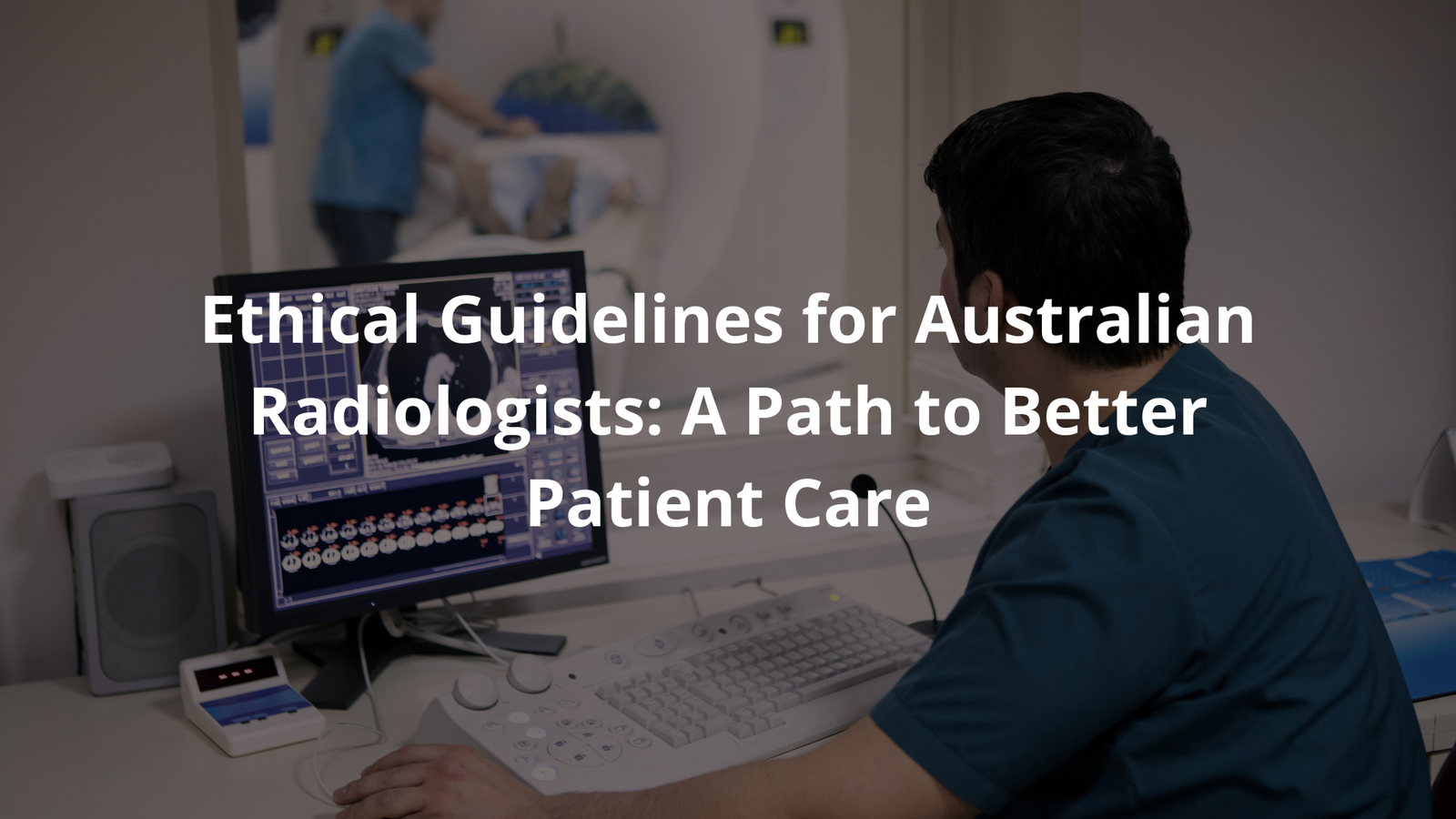This article explores the ethical guidelines for Australian radiologists, focusing on patient care and safety, while integrating new technology.
Australian radiologists have a big job. They look at medical images, like X-rays, helping doctors figure out what’s wrong. But with new tech popping up all the time, ethical rules are super important. These guidelines protect patients and their private info; it makes them feel safe.
Radiologists must use AI responsibly, keeping patient well-being front and centre. It isn’t always straightforward. They must respect patient privacy. Following these rules helps them give the best possible care. Want to know more? Keep reading.
Key Takeaway
- Ethical guidelines help radiologists make good decisions for patient care.
- These guidelines focus on keeping patient information private and safe.
- Continuous education and teamwork are key parts of being a good radiologist.
Understanding Patient Care in Radiology
It striking, watching folks file in and out of the hospital for scans, that so much rests on the radiologist’s shoulders. They’re not just looking at images; they’re looking at people’s futures.
- Communication is Key: Radiologists need to be good communicators. A clear explanation of a CT scan (Computed Tomography, a type of X ray) can do wonders for someone’s nerves. They should talk patients through the whole thing, step by step, so there’s no scary surprises.
- Comfort Matters: Small things matter, too. A warm smile, a kind word, a comfortable room. These little touches can make a big difference to a patients experience.
There’s a duty of care involved. A radiologist has to act in the best interest of the patient, always. That means accurate image interpretation is not just important; it’s essential. And the more radiologists know about diagnosis, the better the patient care. Its a big responsibility, and its easy to see how it all comes down to knowledge.
Informed Consent and Patient Autonomy
It’s amazing, the trust we put in these medical professionals, isn’t it? But trust isnt just given; it’s earned, especially when it comes to patient care. Radiologists play a big part, and informed consent is how they start building that trust.
- Explain the Procedure: A radiologist has to explain the procedure to the patient, in plain language. No jargon! This includes what the scan is for and why its needed.
- Discuss Risks and Benefits: They need to talk about any risks, like radiation exposure (exposure to high energy waves) from X rays. But they also need to explain the benefits. Will it help diagnose whats wrong? How will it guide treatment?
- Respect Autonomy: Patients have the right to say no. This is called patient autonomy, and its a big deal.
When patients are informed, they are more likely to trust their radiologists. Trust improves communication, which helps in making the right decisions. The more a patient understands, the more in control they feel. It is about respecting them, more than anything.
Confidentiality and Privacy Protection
Doctors take an oath. An oath to do no harm, and extends to keeping secrets. When folks go in for medical imaging, they’re trusting that the radiologist will keep their information private. It’s more than just a professional courtesy; its the law.
- Strict Rules: Radiologists must follow data protection rules, no exceptions.
- Secure Systems: They need to use technology responsibly, especially with digital imaging. PACS (Picture Archiving and Communication Systems) must be secure. Its all digital these days; you dont want hackers getting in.
- Training is Key: Training is essential. Everyone on the team needs to know how to keep patient information safe.
If a radiologist shares patient data, even accidentally, it could have serious effects. Imagine if your deepest secrets ended up on the internet. So, data protection isnt just about following rules; its about protecting peoples lives. In the end, its all about trust.
Professional Conduct and Accountability
Credits: Emergency Focus
Watching doctors interact, you can get a real sense of their character. It’s not just about their medical skills; its about how they treat people. Professional conduct is how radiologists behave at work. It’s about caring for patients, and also showing respect for the profession.
- Honesty and Fairness: Radiologists need to be honest, fair, and transparent. No cutting corners, no hiding information.
- Accountability: If they make a mistake, they need to own up to it. Everyone makes mistakes; the key is fixing them and learning from them.
- Commitment to Care: Even if its not what they were asked to look for, they need to report it. It shows they care about the patients welfare above all else.
Accountability might mean reporting an incidental finding on a scan, something unexpected. So it all boils down to this: Professional conduct isnt just a set of rules; its a commitment to doing what’s right, even when it’s hard. It is, in essence, about upholding the dignity of the profession.
Cultural Awareness and Indigenous Health
Australia, is a melting pot, isn’t it? A rich mix of cultures and beliefs, and for radiologists, that means needing a good understanding of cultural awareness. It’s not just about being polite; it’s about providing the best patient care.
- Cultural Sensitivity: Radiologists should learn about different cultures. What are their beliefs? What are their customs?
- Culturally Safe Care: Especially for Indigenous Australians, its all about providing culturally safe care. Understanding traditions and customs can make a big difference.
- Language Barriers: What if a patient doesnt speak English well? Translators are key, or maybe staff who speak different languages.
For example, language barriers can be a challenge. Radiologists need to consider traditional beliefs and how they might affect medical decisions. Cultural awareness isnt just a nice to have; its essential. When radiologists understand cultural differences, they can provide better care. In the end, it all comes down to respect, and theres no better medicine than that.
Continuing Education and Teamwork
It hits you, doesn’t it, how much change there is in the world? Medicine is no exception, with new research and technology coming out all the time. Radiologists have to keep learning, because stopping learning is like stopping breathing.
- Stay Updated: Continuing education is essential. New imaging techniques, radiation safety, and ethical practices are must knows. The more a radiologist knows, the better they can do their job.
- Teamwork is Essential: Radiologists rarely work alone. They work with nurses, doctors, and technicians.
- Collaboration is Key: Sharing ideas and information leads to better patient outcomes. In emergency radiology, quick communication can save lives.
For example, good communication can save lives in an emergency situation. Its all about collaborating effectively. So, radiologists need to be lifelong learners and great team players. It’s not just about individual brilliance; it’s about working together to provide the best possible patient care. It just takes one weak link to cause problems.
Quality Assurance and Risk Management
You ever wonder how hospitals keep everything running smoothly? It’s not just luck, it’s quality assurance. Radiologists are part of that, making sure everything meets a certain standard. High standards, actually.
- Equipment Checks: Making sure the equipment is working properly is key. A broken machine could lead to a wrong diagnosis, and thats no good for anyone.
- Best Practices: Following best practices is also part of it. There are rules and guidelines for a reason; they help keep patients safe.
- Risk Management: What if something goes wrong? Radiologists need to be ready for anything. [1]
Imagine a patient having an allergic reaction to contrast media (a dye used in imaging). The radiologist needs to know how to respond quickly. Risk management isnt just about avoiding problems; its about being prepared to handle them if they happen. Quality assurance and risk management are like two sides of the same coin. Both are necessary to protect patients and provide the best possible care.
Ethical Decision-Making and Beneficence

It’s funny, isn’t it, how much of medicine comes down to making tough calls? Radiologists often face tricky ethical decisions, and there’s a lot on the line. They have to put the patient first, no matter what.
- Patient’s Best Interest: Always put the patients best interest first. This is called beneficence. It means doing what is best for the patient, even if it is not what they want to hear.
- Conflicting Interests: Sometimes, what a patient wants might not be the best thing for them. What if they want a test that isnt necessary?
- Guidance is Key: Radiologists need to explain why a test might not be helpful. They need to guide patients towards better health decisions.
So, for example, a radiologist might have to explain why a certain test isnt needed. This isnt always easy, but its part of the job. Ethical decision making means putting aside personal feelings and doing what is best for the patient. It’s about guiding them toward better health, even when its not what they initially wanted. In a way, it’s like being a doctor and a teacher, all rolled into one. [2]
FAQ
How Do Radiologists Manage Radiation Safety and Exposure?
Radiation safety is critical in medical imaging. Radiologists carefully manage radiation exposure, particularly in pediatric and geriatric imaging. They follow strict protocols to minimise risks, use technological advancements like artificial intelligence and machine learning to optimise imaging, and provide follow-up recommendations that prioritise patient health and safety.
What Principles Guide Cultural Awareness in Radiology?
Cultural awareness is essential in healthcare. Radiologists provide culturally safe care, especially for Indigenous patients and in rural and remote practices. They respect health equity, understand gender considerations, and communicate effectively across diverse communities. This approach ensures inclusive, respectful, and patient-centered diagnostic services.
How Do Radiologists Maintain Professional Development and Collaboration?
Continuing education is crucial for radiologists. They engage in peer review, mentoring, and leadership programs to enhance skills. Multidisciplinary collaboration ensures comprehensive patient care, while embracing technological advancements and evidence-based practices. This commitment supports ongoing professional growth and improves healthcare outcomes.
What Are the Ethical Considerations in Digital Imaging and Data Management?
Digital imaging and teleradiology require robust ethical frameworks. Radiologists prioritise data protection, maintain privacy in remote consultations, and follow research ethics. They use PACS systems responsibly, manage incidental findings transparently, and ensure comprehensive, accurate radiology reports that support clinical governance.
How Do Radiologists Address Workplace and Environmental Responsibilities?
Radiologists are committed to workplace safety, resource allocation, and environmental sustainability. They manage occupational health risks, implement continuous improvement strategies, and consider broader healthcare system impacts. This holistic approach demonstrates professionalism and social responsibility in medical imaging practice.
Conclusion
Ethical guidelines for Australian radiologists? They’re all about patient care, safety, and being professional. They help radiologists make good decisions, keep patient info safe, and stress teamwork. Plus, its all about staying up to date, with medical education always a priority. By following these guidelines, radiologists can provide the best care, because patients deserve to feel respected, valued, and heard. It all starts with a commitment to doing what is right.
References
- https://pmc.ncbi.nlm.nih.gov/articles/PMC9291743/
- https://www.acpsem.org.au/Tenant/C0000020/FOCUS%20Newsletter/2020%2004%20-%20April/Standards%20of%20Practice%20v11.0.pdf




